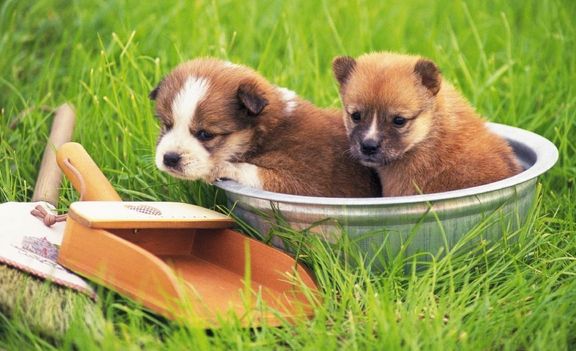United States: Pet waste A crap-shoot
美國:寵物糞便,從糞便里發出的新芽
The city ponders a plan to make power from puppy poop.
在寵物糞便中提取能源,該市構建著一幅如此藍圖。
Dogs, unlike people, are capable of pure love—at least according to Freud.
與人類不同,狗對主人的情感是純潔無瑕的——至少弗洛伊德是這么說的。
As ever more Americans live alone, unconditional affection is in demand.
隨著美國獨居人數的增多,這種無條件的愛更是廣受歡迎。
Pet ownership has risen for decades.
數十年來,越來越多的人開始飼養寵物。

More than a third of homes have at least one dog, according to the American Veterinary Medical Association.
根據美國獸醫協會的調查,超過三分之一的家庭養了至少一只寵物狗。
But the popularity of four-legged friends has an icky cost: dogs squeeze out more than twice the waste of the average person, or around 275 pounds a year.
但四條腿朋友的盛行代價也是惱人的:狗年均排泄量比人均兩倍還要多,大概一年在275磅左右。
With over 83m pooches roaming the country, that is a lot of poop.
超過8300萬流浪狗游走在城市之間,這可是個不小的“糞”量。
Around 60% of the stuff gets scooped and trucked to landfills, where it releases methane, a greenhouse gas.
約60%的糞便會被挖走并運到釋放溫室氣體甲烷的沼氣填埋池。
The rest delivers surprises to pedestrians and can contaminate waterways, as carnivorous diets create pathogen-rich waste.
剩余的便便在驚到路人的同時還會污染河流,因為這種肉食性的飲食會制造出大量攜帶病菌的排泄物。
The problem is particularly bad in cities, where green spaces are few and lonely souls seeking puppy love plentiful.
這個問題在城市里極其嚴重,因為綠化少,而尋求寵物情感關愛的孤獨身影卻尤為多。
New York boasts over 600,000 hounds—one for every 14 people—generating over 100,000 tons of turd a year.
紐約市以擁有逾60萬只寵物狗而自豪——平均每14個人就會飼養1只——它們一年將會制造10萬多噸排泄物。
Some of it smudges unlucky stilettoes, but most is dutifully tossed into rubbish bins and hauled to landfills, at a cost of over $100 per ton.
一部分會弄臟不走運的穿高跟鞋的女士,而大部分則會被負責地扔進垃圾箱,運到沼氣填埋池——大概1噸會花費一百多美元。
This is a missed opportunity, says Ron Gonen, the city's former recycling tsar.
“這簡直就是錯失良機。”前城市“回收沙皇”羅恩·戈南說道。
Now in the private sector, he is trying to launch “Sparky Power”, a programme to transform dog waste into clean energy in the city's dog parks.
如今,在私營企業的他正準備啟動一項名為“生機能源”的項目,該項目旨在將城市寵物公園的糞便轉化成清潔能源。
The idea is to fit parks with small anaerobic digesters.
這個想法的初衷是在公園里安裝小型厭氧化糞器。
Dog owners would place their mongrels' mounds into the machine, which then converts poo to gas for powering lamps and other park equipment.
寵物主人把小狗們的糞便放入化糞器,該設備隨即將糞便轉化成氣體燃料,用于為路燈和其他公園設備供電。
A year-long pilot would introduce digesters in three parks at a cost of around $100m.
一個為期一年的試點項目將花費近1億美元將化糞器投入到三個公園中使用。
The parks department is pondering the proposal.
公園部門正在考慮此項提議。
Similar schemes in other cities have proved short-lived.
類似的方案在其他城市曇花一現。
An underground Energy Transformation Using Reactive Digestion (E-TURD) device created by Arizona State University students for a dog park in Gilbert, Arizona, in 2012 ultimately failed.
亞利桑那州立大學的一名學生為吉爾伯特鎮的寵物公園設計了一套名為E-TURD的地下能源轉換設備,該設備通過化學消化來實現能源轉化。然而該項目最終于2012宣布失敗。
“It's great to turn it into a biofuel, but first you gotta pick it up,” says Tom Boyd, an entrepreneur in Tennessee.
“把糞便轉化成生物燃料的點子真是太棒了,但是首先你得把它們撿起來。”一個田納西州的企業家湯姆·博伊德說道。
His company, Poo Prints, shames the owners of dogs who fail to clean up their messes by testing DNA in uncollected coils.
他的公司“便便印記”通過檢驗便便DNA來讓那些不清理寵物散落的糞便的狗主人無地自容。
There are enough offenders to secure a new customer every two hours, he says.
他說,“罪犯”過多,以至于每兩小時就能為他們帶來一名新客戶。
Most are landlords of smart apartment complexes, but in September the company launches its first district-wide programme—in the London borough of Barking and Dagenham, naturally.
顧客大多數都是高檔住宅小區的老板,九月,該公司將開啟首次跨國項目——地點當然是在倫敦的巴金達格南區。



